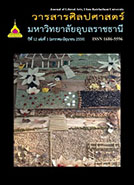ภูมิปัญญาผ้าไหมลายลูกแก้วของกลุ่มชาติพันธุ์ในจังหวัดศรีสะเกษ
Main Article Content
บทคัดย่อ
บทความนี้เป็นการศึกษาภูมิปัญญาผ้าไหมลายลูกแก้วย้อมมะเกลือ ของ กลุ่มชาติพันธุ์ ส่วย เขมร ลาว และเยอ ในจังหวัดศรีสะเกษ มีวัตถุประสงค์ เพื่อ ศึกษาภูมิปัญญาเกี่ยวกับการผลิตผ้าไหมลายลูกแก้วย้อมมะเกลือ ของกลุ่มชาติ พันธุ์ ส่วย เขมร ลาว และเยอ ในจังหวัดศรีสะเกษ กลุ่มตัวอย่างในการวิจัยครั้งนี้ ประกอบด้วยกลุ่มชาติพันธุ์ส่วยบ้านเปือย หมู่ที่1 ตำบลพรมสวัสดิ์ อำเภอพยุห์ กลุ่มชาติพันธุ์เขมร บ้านเมืองหลวง หมู่ที่ 3 ตำบลเมืองหลวง อำเภอห้วยทับทัน กลุ่มชาติพันธุ์ลาว บ้านทุ่งไชย หมู่ที่ 3 ตำบลทุ่งไชย อำเภออุทุมพรพิสัย กลุ่มชาติ พันธุ์เยอ บ้านปราสาทเยอ หมู่ที่ 1 ตำบล ปราสาทเยอ อำเภอ ไพรบึง ของจังหวัด ศรีสะเกษ ซึ่งผ้าไหมลายลูกแก้วที่มีการผลิตในชุมชนของแต่ละกลุ่มชาติพันธุ์แม้ว่า จะเป็นผ้าลายลูกแก้วเหมือนแต่จะมีรายละเอียดที่ไม่เหมือนกัน โดยพบว่า ภูมิปัญญาในการทอผ้าไหมลายลูกแก้วในแต่ละกลุ่มชาติพันธุ์มีวิธีการเหยียบไม้ เก็บตะกอไม่เหมือนกัน กลุ่มชาติพันธุ์ส่วยและเยอทอด้านบนผืนผ้าเป็นลายเส้น ยืน ด้านล่างเป็นลายเส้นพุ่ง แต่ในกลุ่มชาติพันธุ์เขมรและลาว ด้านบนจะเป็น ลายเส้นพุ่ง ด้านล่างเป็นลายเส้นยืน กลุ่มชาติพันธุ์ลาวยังมีการทอแบบลายที่เกิด จากเส้นพุ่งทั้งด้านบนและด้านล่างด้วย ภูมิปัญญาในการย้อมมะเกลือในแต่ละกลุ่มชาติพันธุ์มีรายละเอียดในกระบวนการย้อมที่แตกต่างกัน กลุ่มชาติพันธุ์เขมร และลาวนิยมใส่พืชที่ให้กลิ่นหอม เช่น ใบเล็บครุฑ ต้นสาบแร้งสาบกา และว่านหอม เป็นต้น ส่วนกลุ่มชาติพันธุ์ส่วย มีนวัตกรรมใหม่ คือใส่น้ำยาซักผ้าขาวร่วมกับ การย้อมมะเกลือเพื่อให้เสื้อสีดำเร็วขึ้น การปักเย็บในแต่ละกลุ่มชาติพันธุ์มี การสร้างสรรค์ลวดลายต่างกันจนเกิดเป็นอัตลักษณ์ กลุ่มชาติพันธุ์เขมร มีเข้าตะเข็บ ด้วยลายตีนตะขาบ และกลุ่มชาติพันธุ์ลาวเข้าตะเข็บด้วยลายเอวมดแดง เพียง รอบเดียว กลุ่มชาติพันธุ์ส่วยมีการเย็บตะเข็บสองรอบคือ เย็บด้วยลายขามดแดง แล้วจึงเย็บหางสิงห์อีกครั้งหนึ่ง ส่วนในกลุ่มชาติพันธุ์เยอไม่พบการปักเย็บที่เป็น ลวดลายเหมือนกลุ่มชาติพันธุ์อื่น ๆ
This article aims to study the wisdom of grass ball pattern with dyed ebony silk weaving of these ethnic groups: Suai, Khmer, Lao, and Yoe in Sisaket province. The samples in this study were: 1) Suai ethnic group in Puay viilage, moo 1,Promsawad district, Phayu district. 2) Khmer ethnic group in Muang Laung village, moo 3, Muang Laung subdistrict, Huai Thap Than Distric 3) Lao ethnic group in Tung Chai village, moo 3, Tung Chai subdistrict, Uthompornpisai district. 4) Yoe ethnic group, Prasat Yoe village Moo 1 Prasat Yoe subdistrict, Phrai Bueng district. Although the silks woven in this community had same grass ball pattern, there were some different details. The results found that the wisdom of heddle weaving in each ethnic group was different styles. Suai and Yoe ethnic groups wove the silk by using standing line pattern on the top of the silk, but on the bottom was up line pattern .
In contrast, Khmer and Lao ethnic groups had different of the silk woven style. On the top of the silk was up line pattern and the bottom was standing line pattern. Moreover, Lao ethnic group’s silk woven shown up line pattern on the top and the bottom. The wisdom of dyed ebony silk in each ethnic group was different on detailed in the dyeing process. Khmer and Lao ethnic groups usually put some fragrant plants, such as Polyscias lave, Goat weed, and Sand ginger. Suai ethnic group had a new innovation by putting some bleach and dyed ebony together in order to make the silk became black quickly. The needle work in each ethnic group has created different patterns to show each ethnic group’s identity. In Khmer ethnic group, there was a seam pattern, shown centipede’s leg pattern. Lao ethnic group, there was one round seam, shown red ants’ waist pattern. But in Suai ethnic groups sewn a seam for two rounds. First, the silk was sewn by red ant’s legs pattern and then sewn by Singh’s tail pattern again. However, Yoe ethnic group could not be found any pattern in the silk like other ethnic groups.


